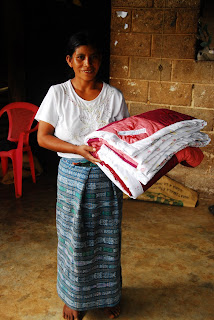
Tuesday, August 4th, 2009
I write from the comforts of the big red chair in the living room of my home in Snohomish, Washington. In the beautiful Pacific Northwest. The NW really is so beautiful. It is so great to be at home again with my family, my dogs, to walk around the beautiful garden, water the apple trees, to have fresh raspberries for my cereal and plump blueberries that I eat write off the bush.
I got home Sunday night around 10:30pm and have since spent the time relaxing.
My final destination in Guatemala, Lake Atitlan, was supposed to be filled with relaxation. However, while on a hike to Indian Nose (a mountain shaped in the pface of a person with a prominent nose), I was robbed and assaulted by 4 young men, 2 of whom were carrying machetes. I am okay :) but the experience was quite scary.
I had asked 2 people (one of whom was a guide) at the place I was staying if it was safe to do the hike alone. The response I got: "Yeah, you'll be okay. You're a man, they shouldn't bother you." Well, after hiking up the road for about just over an hour I started to catch up to a group of youth who were walking behind an older man. As they approached a blind corner, one looked back, spotted me and motioned to the others to stop. I noticed this and started to call out loudly (so they knew the older man knew I was there-or that was my intent), "Hey, how's it going? What are you guys up to?" One of the teens immediately pulled out a machete, pointed it at me and stalked towards me, saying: "Give me your money." I purposely didn't bring any money so this wouldn't happen and told him that. That didn't stop them from pulling my shirt up and sticking their hands under my belt (looking for a money belt) and into my pockets. I let them do so, out of pure shock and hoping that they would see I had no money and walk away. After repeating that I didn't have any money, the boy then said, "well, the backpack then" and another boy started to try to cut the straps off my backpack (which I was wearing) with his machete. This bolted me into action as my backpack had my camera in it. (My nice, new camera, but more importantly a lot of pictures that I had yet to save somewhere else) So, I grabbed the first thief's machete (which was inches from my face) and pushed away and tried to get away from their grasps. After a few attempts to run(it was impossible with 4 people holding onto different parts of me (trying to take off my watch) and my backpack I started to yell, "Thieves! Thieves, help me!" With this, I was able to break from their relaxed grasps and they ran off, up the hillside taking my room key and a bandanna from my pocket. I yelled in fury after them, "Hacen falta" (it's what fans cry after a foul in futbol, but I think I got my point across)
I am very grateful that God protected me during this incident and nothing worse happened. Their are stories of strong, grown men losing their shoes and shirt right off their back in past robberies.
A hundred meters up the road I met worker who offered to take me up to the top in safety for 5 bucks (the thieves don't attack when you're with a local), which I agreed to. We made it to the top and back down, without further incident. Though along the way we saw a few other young boys with machetes who Pablo, my guide, said were likely other potential thieves.
This was a horrible way to end my trip. I know the Guatemalan people are a beautiful, humble, giving people and they have shared so much with me even in the midst of their poverty. But, it is one part of the reality of this country, where corruption prevails in government and many people don't have jobs. Some of these people resort to theft. Maybe it is out of desperation to feed their families. In this case for these boys about my age, it was more likely out of want to buy an iPod or cellphone. Even in a country as poor as Guatemala, these modern symbols of luxury are everywhere.









